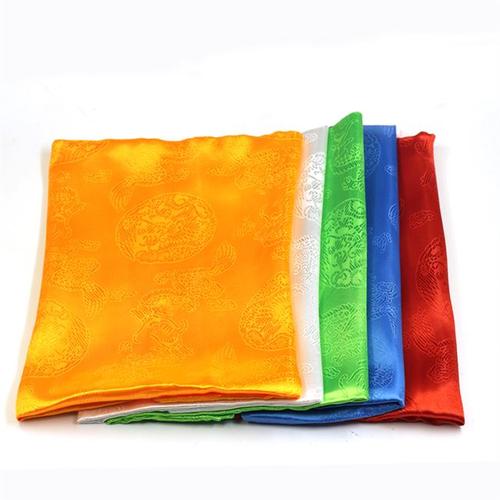How to Present and Receive Hada
A very unique tradition in Tibet, the Hada is presented as a traditional way of showing respect and hospitality to visitors to Tibet. The Hada is a long scarf, usually white and made from silk, which symbolizes the purity of the heart of the giver. The Hada itself symbolizes purity and compassion and is presented on a number of occasions in the Tibetan traditions, from greeting visitors to weddings and other family ceremonies.

Table of Contents
Origins of Tibetan Hada
The exact origins of the Hada have varying stories. One popular story tells of how the Han Dynasty missionary, Zhangqian, passed through Tibet on a diplomatic mission and presented silk cloths, prized in China and symbolizing pure friendship, to the local chieftain. Believing this to be a courtesy to build friendships, the tribe turned the giving into a custom. Another myth tells of how the Tibetan king Wangbasi brought colorful silk Hada back from a meeting with Kublai Khan of Mongolia that had “jixiangruyi” in Chinese on it, which means “good luck and happiness to you”. In later years, Hada became synonymous with being the ribbons in the clothes of the fairy maidens and was given religious meanings.

Correct ways to present Hada
Presenting Hada in Tibet requires a specific form of presentation, and how it is presented actually depends on who it is being presented to. The presenting of Hada is the most common of all the Tibetan etiquettes and is meant to show the purity of spirit, honesty, sincerity, and respect to those receiving the Hada. And there are several different ways of presenting the Hada, which depend on who you are presenting it to.
To living Buddha or the elder
For an elder or a Living Buddha, the presentation of the Hada is the most formal and deferential of all, as this is a presentation to what is considered to be a living god. When presenting the Hada, the giver raises the white scarf to the level of his shoulders in both hands, and bows forwards, inclining his head so that it is facing down to the floor, with the Hada level with the top of his head. The Hada is then laid in front of the seat or at the feet of the Living Buddha, who will receive it graciously. Raising the Hada above the head is the ultimate mark of respect in the tradition, and when presenting Hada to elders or the living Buddha, you are showing them your utmost respect and sincerity, showing that the Hada is given in honesty and purity.
To friends and visitors
To friends or members of the same generation, as well as to visitors to Tibet from foreign lands, the Hada is presented somewhat differently. Instead of presenting the Hada bent over, the Hada is presented towards the person receiving it with bowed head, and laid around the neck of the receiver. In some instances, the Hada is presented to the receiver, who receives in and lays it around his own neck.
Correct ways to receive Hada
Just as there is a correct way to present a Hada, there is also a correct way to receive one. And while the presentation is important to Tibetan people, the way it is received is just as important to them.

The correct body gesture to receive a Hada
For receiving a Hada in your hands, you should extend them both out at arm’s length, with the palms facing upwards and your head slightly bowed in deference. The giver will lay the Hada onto your palms, with bowed head, after which you should immediately lay the Hada around your neck and wear it during your meeting.
Taboos when receiving Hada
In Tibetan customs and traditions, the Hada, once given, is not put down. The receiver will wear the Hada for the whole duration of the visit of the one who gave it, and not take it off until the guest or visitor has left again, or you have left the meeting. It is actually considered to be very rude to refuse the Hada when offered, and no Tibetan would ever refuse, as this is considered to be an insult to the honesty and integrity of the giver.
Likewise, it is not done to put the Hada down after receiving it instead of wearing it, and you should take care not to sit on the Hada when you sit down. The Hada is very long, and you should always make sure that when you sit down after receiving it, you are not sitting on the ends of the scarf. Simply accept it graciously and wear it for the duration of the time you are with the giver. When you arrive in Tibet, you will receive Hada from your guide, and you can see lots of people in the city wearing them after being presented.
What to do with the received Hada?
So what do you do with the Hada after you have received it? This is something only you can choose to do, and what you do with the Hada has a certain meaning for the receiver and giver. Just don’t throw it away or lose it.
Take it home as a souvenir
One of the most popular things for international travelers to do with their Hada is to take them home as a souvenir of their Tibet trip and to remember the person that gave it to them. And this is a perfectly fine thing to do. Keeping the Hada, putting it away while you travel on through Tibet, and then bringing it home with you to keep forever is respectful to the person that presented it to you, and shows honesty and integrity of your own. The Hada is a gift of respect and hospitality, and to keep it is to show respect for the person that showed you such friendship and hospitality in Tibet. And the Hada does make a great souvenir of your trip to the plateau region.
Tie it at a mountain pass or other holy site
Another option for those that want to show respect to the Buddha in Tibetan Buddhism, is to place the Hada at some holy site. Leaving the Hada at a holy religious site is another mark of respect for the site and for the giver, as it means you are passing on the hospitality to the world and the gods.
As you travel around Tibet, you can see Hada tied to Main stone walls and tied to trees at holy sites near lakes and mountain passes. Many of these Hada has been left here by tourists to Tibet, who want to make their own contribution to giving blessings to the world and use their Hada instead of prayer flags. The act of giving in this way represents your respect for the site. Hada is also often thrown to the religious Thangka at ceremonies on various monasteries around the region.
Recent Posts
Top 5 Most Asked questions on Tibet Travel
7 Tips for a Successful Trip to Tibet
A Journey to Everest Base Camp in Tibet
All Categories
- About Tibet
- book a Tibet tour
- Buddhism Practice
- Budget Tour
- China-Tibet Train
- Customized Tibet tour
- Historical Sites
- Hot Springs in Tibet
- News
- Photography in Tibet
- Tibet attraction
- Tibet Group Visa
- Tibet Motorcycle Tour
- Tibet Small Group Tours
- Tibet Tours and Tibetan Tour Guide
- Tibet Train
- Tibet Travel FAQs
- Tibet Travel Information
- Tibet Travel News
- Tibet Travel Permit Update
- Tibet Travel Prices Rises
- Tibet Trek
- Tibet Trekking Tour
- Tibet weather and climate
- Tibet Wildlife animals
- Tibet Winter Tour
- Tibetan Buddhism
- Tibetan Cultural Features
- Tibetan Culture and Poeple
- Tibetan Festivals
- What to see in Tibet


